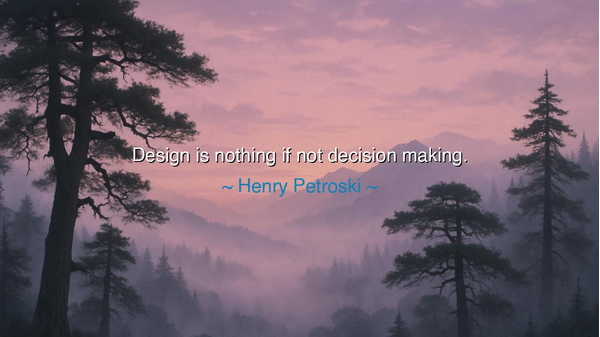
Design is nothing if not decision making.






“Design is nothing if not decision making.” So spoke Henry Petroski, the wise chronicler of engineering’s soul. His words are not a simple praise of the designer’s craft—they are a revelation. For in every line drawn, in every form conceived, and in every choice between beauty and function, a thousand unseen decisions are made. These decisions—small or grand—are the heartbeat of all creation. Without them, design is a hollow shell, a body without will, a melody without rhythm. To design, therefore, is to choose—to discern between what may be and what must be.
In the days of old, when builders raised cathedrals to touch the heavens, they too were faced with choices. How thick should the stone wall be to bear the weight of faith? How high should the arch rise so that light may pour through like divine grace? Every measure, every curve, every placement of glass and stone was a decision, both technical and spiritual. Thus, the cathedral stood not as an accident of art, but as a monument to human judgment. It was built upon a thousand moments of “yes” and “no,” each one shaping the destiny of the structure, and in turn, the destiny of its people.
The meaning of Petroski’s words reaches deeper still. He teaches that design is not a single act of inspiration, but a continuum of choices, made in uncertainty, made in hope. The designer, whether of bridges, poems, or lives, must stand firm amid doubt. To design is to face the void—to wrestle with chaos until order emerges. Every hesitation, every revision, is a decision deferred, and every step forward, a declaration of intent. The wise designer does not wait for perfection to reveal itself like a miracle; instead, they choose, and through their choosing, perfection is slowly carved from imperfection.
Consider the story of the Brooklyn Bridge, that iron hymn to human daring. John Roebling dreamed it, his son Washington built it, and Emily Roebling—his wife—saw it through when sickness claimed his strength. In the long years of struggle, when cables snapped and critics mocked, she made decision after decision, weighing safety against ambition, loyalty against exhaustion. When others hesitated, she chose. When others feared, she acted. It was decision-making, not mere design, that raised that bridge from river mist to skyline glory.
Petroski reminds us that design is not reserved for architects or engineers alone. Each soul is a designer of their own existence. Every choice—what to love, what to abandon, what to endure—is a line drawn in the grand blueprint of one’s life. Some choose comfort and call it peace; others choose struggle and call it purpose. But the truth remains: the act of choosing is the act of becoming. To refuse decision is to refuse creation itself. For indecision is the death of design, just as silence is the death of song.
Therefore, let the young and the wise alike remember this: to live well is to design one’s days with care, with courage, and with conscience. Do not fear your decisions—fear the emptiness of not deciding. Stand before your life as an architect stands before an unbuilt city. Ask not for certainty, but for the strength to choose, and to choose again, until your design stands strong and true.
So when you next face the crossroads of creation—be it in craft, in love, or in destiny—remember the words of Petroski. Let them echo through your heart like a bell of awakening: “Design is nothing if not decision making.” Choose boldly, choose wisely, and through your choices, let the shape of your spirit be known. For it is in the act of deciding that we not only design the world—but design ourselves.






AAdministratorAdministrator
Welcome, honored guests. Please leave a comment, we will respond soon